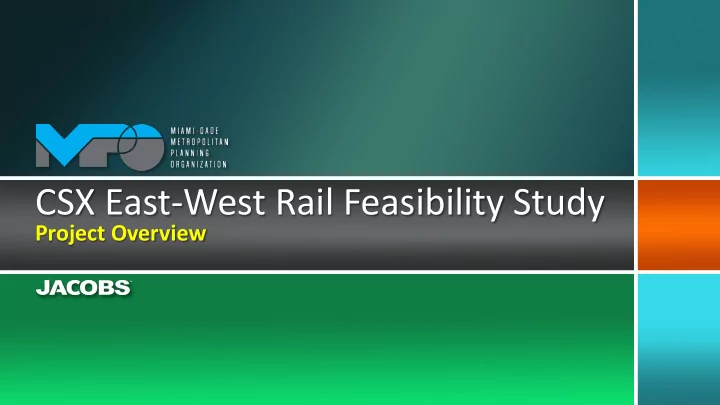

CSX East-West Rail Feasibility Study Project Overview
Background and Approach • Purpose and Need • Technology Assessment • Technical Analysis Ridership Capital Costs Operation and Maintenance Costs • Evaluation and Refinement • Finance and Implementation • Role of SAC
Issues and Opportunities • Dolphin Expressway (SR 836) one of Miami-Dade’s most congested corridors serving over 200,000 vehicles per day • Existing industrial railroad network and conditions • Potential joint freight and passenger use • State and CSX-owned industrial tracks parallel SR 836 west from the Miami Intermodal Center (MIC) • Connections to Metrorail, Tri-Rail and Amtrak at the MIC • Other BRT & Express Bus Plans
Corridor Description Right-of-Way 100’ width • CSX Ownership • FDOT Ownership • Multiple grade • Crossings Freight Operations •
Prior Corridor Studies 2009 MPO CSX Corridor Study 2001 SFRTA “Dolphin Extension” 2005 Peoples Transportation Plan Dolphin Corridor Commuter Rail
Corridor Socioeconomic Conditions Population Density • Residences predominantly located south of the CSX rail corridor • 139,876 residents located within 1 mile corridor buffer (2010 census)
Corridor Socioeconomic Conditions Employment Density • Higher concentration of jobs and employment centers located north of the CSX rail corridor and west of the airport • 135,524 jobs located within 1 mile corridor buffer (2010 census)
Corridor Land Use • Mixed employment and residential centers located north of the CSX rail corridor • Majority residential uses located south of the CSX rail corridor • Vacant and undeveloped land located west and northwest of the CSX rail corridor
Existing Traffic Conditions Existing Conditions Level of Service (2011/2012)
Corridor Infrastructure • Track / Infrastructure / Structures / Grade Crossings • Current / Future Freight Operations • Existing Customers, Siding Agreements • Provide seamless connections to Tri-Rail and Metrorail
Preliminary Service Concepts Concept One: • 9.5 mile diesel light rail transit (DLRT) route • 6 stations in addition to the MIC • Mostly double tracked to accommodate traffic • Matches the schedule, frequency and hours of service of the Orange Line
Preliminary Service Concepts Concept One: • 10 minute peak period headways • 15 minute off-peak headways • 5 minute timed transfers with Orange Line • Off-peak trains held up to 5 minutes for late arriving connections • 122 nd Ave to Government Center in 38 minutes • Freight restricted to 10:00 pm to 5:00 am
Preliminary Service Concepts Concept Two: • 15 mile diesel commuter rail route similar to Tri- Rail • 7 stations in addition to the MIC • Mostly single track with one or more sidings • Potential to interline or operate as an extension of existing Tri-Rail service
Preliminary Service Concepts Concept Two: • 30 minute peak period headways • 60 minute off-peak headways • Off-peak trains held up to 5 minutes for late arriving connections • Krome Ave to Government Center in 52 minutes • Freight operations accommodated during the midday, evening and overnight periods
Preliminary Service Concepts Concept Three: • Diesel light rail route from 137 th Avenue and FIU to MIC • 9 stations in addition to MIC • Mostly double tracked • 2 coordinated services on shared track, focusing on different travel markets
Preliminary Service Concepts Concept Three: • “Turnpike” route - 11 miles between 137 th Avenue and MIC • “FIU” route - 10 miles between FIU and MIC with 2.2 mile branch south along median of 107 th Avenue • Branch along 107 th Avenue could be single track to reduce impacts on roadway traffic
Preliminary Service Concepts Concept Three: • 15 minute peak and 15 minute off-peak headways on shared trunk stations • 30 minute peak and 30 minute off-peak headways to FIU and Turnpike routes • 5 minute timed transfers with Orange Line • FIU to Government Center in 42 minutes • Freight restricted to 10:00 pm to 5:00 am
Preliminary Challenges • Matching Tri-Rail and Amtrak Schedules • Matching Metrorail’s Schedule • Maintain needs of industrial clients • Provide ample Park-n-Ride facilities • Maintain potential for future branch line extensions • Funding and project implementations
Study Advisory Committee (SAC) • Study Advisory Committee (SAC) May – August/September – November • Informational Meetings • Website
Study Schedule Apr May Jun Jul Aug Sep Oct Nov Dec Jan SAC Meetings Background and Existing Conditions Develop Initial Alternatives Refine Initial Alternatives Evaluate Final Alternatives Implementation Plan Findings and Recommendations Final Report / MPO Presentation
Discussion • 3 Preliminary Service Alternatives – MIC to Turnpike (Turnpike Alternative) – MIC to Krome Avenue ( Krome Alternative) – MIC to FIU ( FIU Alternative) – MIC to Kendall – Connection to Douglas Road Corridor – Others?
CSX East-West Corridor
Questions CSX East-West Rail Feasibility Study Project Overview
Recommend
More recommend